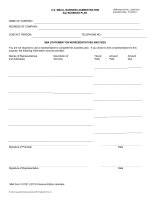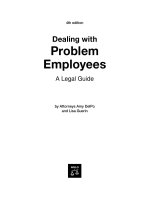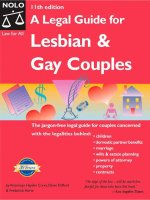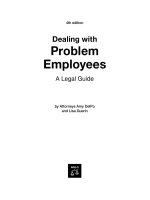Understanding business 10th appendix a legal
Bạn đang xem bản rút gọn của tài liệu. Xem và tải ngay bản đầy đủ của tài liệu tại đây (370.78 KB, 40 trang )
Bonus
Chapter A
Working
within the
Legal
Environment
McGraw-Hill/Irwin
Copyright © 2014 by The McGraw-Hill Companies, Inc. All rights reserved.
Bonus Chapter
A
LEARNING GOALS
1. Define business law, distinguish between statutory and
common law, and explain the role of administrative
agencies.
2. Define tort law and explain the role of product liability in
tort law.
3. Identify the purposes and conditions of patents,
copyrights, and trademarks.
4. Describe warranties and negotiable instruments as
covered in the Uniform Commercial Code.
5. List and describe the conditions necessary to make a
legally enforceable contract, and describe the possible
consequences if such a contract is violated.
A-2
Bonus Chapter
A
LEARNING GOALS
6. Summarize several laws that regulate competition
and protect consumers in the United States.
7. Explain the role of tax laws in generating income
for the government and as a method of
discouraging or encouraging certain behaviors
among taxpayers.
8. Distinguish among the various types of bankruptcy
as outlined by the Bankruptcy Code.
9. Explain the role of deregulation as a tool to
encourage competition.
A-3
Profile
KENNETH FRAZIER
Merck
• Frazier started as Merck’s
general counsel in 1999.
• Greatest challenge was a
sea of lawsuits involving
Vioxx - arthritis drug caused
heart attacks and strokes.
• Frazier won 11 of 16 lawsuits
at trial before agreeing to a
settlement fund.
A-4
Bonus Chapter
A
NAME that COMPANY
This automaker sells more cars in the United
States than any other auto producer. In 20102011, however, the company was forced to
recall 3 million cars due to sudden accelerator
incidents. It’s likely the company will face years
of litigation from customers that were affected
by the product problem.
Name that company!
A-5
The Case for
Laws
The NEED for LAWS
LG1
• Laws are a key part of a civilized society, but
must change with the times.
• Judiciary -- The branch of government chosen to
oversee the legal system through a system of courts.
• The U.S. courts system is organized at the
federal, state, and local levels.
A-6
The Case for
Laws
TYPES of COURT
LG1
• Trial courts hear cases of
criminal and civil law.
• Appellate courts hear
appeals from the losing
party at the trial court level.
A-7
The Case for
Laws
TYPES of LAW
LG1
• Criminal law defines crimes, establishes
punishments, and regulates the investigation and
prosecution of people accused of committing crimes.
• Civil law proceedings cover non-criminal acts divorce, personal injury lawsuits and more.
• Business Law -- Refers to the rules, statutes,
codes and regulations that provide a legal framework
for the conduct of business.
A-8
Statutory and
Common Law
MAJOR AREAS of LAW
LG1
• Statutory Law -- Includes state and federal
constitutions, legislative enactments, treaties of the
federal government and ordinances; written law.
• Common Law -- The body of law that comes from
decisions handed down by courts; unwritten law.
• Precedent -- Decisions judges have made in
previous cases to guide their handling of new cases.
A-9
Administrative
Agencies
ADMINISTRATIVE AGENCIES
LG1
• Administrative Agencies -- Federal or state
institutions and other government organizations with
delegated power to create rules and regulations
within their given area of authority.
• Examples of Administrative Agencies:
- The Federal Reserve Board
- The Securities and Exchange Commission
- The Equal Employment Opportunity Commission
- The Federal Trade Commission
A-10
Progress
Assessment
PROGRESS ASSESSMENT
• What is business law?
• What is the difference between statutory and
common law?
• What is an administrative agency?
A-11
Tort Law
WHAT is TORT LAW?
LG2
• Tort -- A wrongful act that causes
injury to another person’s body,
property or reputation.
• An Intentional Tort is a willful
act that results in injury.
• Negligence – Behavior that
causes unintentional harm or injury.
A-12
Product Liability
PRODUCT LIABILITY LAWS
LG2
• Product Liability -- Holds businesses liable for
harm that results from the production, design, or
inadequate warnings of products they market.
• Strict Product Liability -- Liability without regard
to fault; a company can be held liable for a defective
product even if they didn’t know of the defect.
A-13
Product Liability
LG2
MAJOR CURRENT
PRODUCT LIABILITY CASES
Company
Arup, USA, Inc.
Chrysler
Metro-North
Railroader
Tesla Motors,
Inc.
Date
Settlement
April 9,
2014
Engineering firm Arup helped design Miami's new art museum, suing
two contractors on the project 4/8/14 for nearly $7M for allegedly
failing to heed warning signs of brittle steel bolts which caused the
November 2012 collapse of three large t-beams.
April 9,
2014
Chrysler was hit with a suit 4/2/14 in Texas federal court
alleging its Dodge Durango line of SUVs do not have skid
plates or other methods to protect the fuel tank from
undercarriage strikes, which can cause injury to drivers.
April 9,
2014
Railroad worker from Westchester, N.Y., was paralyzed in
deadly Dec. 1 derailment, sued the commuter railroad 4/7/14
for $100M under N.Y. common law and under the Federal
Employers Liability Act, which protects rail workers.
April 8,
2014
Milwaukee man filed first-ever lemon law case against Tesla,
alleging 4/7/14 that his Model S is defective and has spent
more than a month in the shop, according to a video posted
on YouTube by attorney Vince Megna.
A-14
Legally Protecting
Ideas: Patents,
Copyrights and
Trademarks
LG3
PATENTS, COPYRIGHTS, and
TRADEMARKS
• Patent -- A document that gives inventors exclusive
rights to their inventions for 20 years.
• Copyright -- Protects a
creator’s rights to materials such
as books, articles, photos,
paintings, and cartoons.
• Trademark -- Is a legally
protected name, symbol, or
design that identifies the goods
or services of a seller.
A-15
Legally Protecting
Ideas: Patents,
Copyrights and
Trademarks
PATENT FACTS
LG3
• Patent applicants should
seek the advice of a lawyer.
• Foreign applicants are
eligible to file U.S. patents.
• Patent owners have the
right to sell or license the
use of their patent to others.
A-16
Legally Protecting
Ideas: Patents,
Copyrights and
Trademarks
PATENT LEADERS in 2013
LG3
Company
# of Patents
Home Country
IBM
6,809
USA
Samsung
4,676
Korea
Canon
3,825
Japan
Microsoft
2,660
USA
Panasonic
2,601
Japan
Source: IFI Patent Intelligence, 2014
A-17
Progress
Assessment
PROGRESS ASSESSMENT
• What is tort law?
• What is product liability? What is strict product
liability?
• How many years is a patent protected from
infringement?
• What is a copyright?
A-18
Sales Law:
The Uniform
Commercial
Code
LG4
WHAT is the
UNIFORM COMMERCIAL CODE?
Uniform Commercial
Code (UCC) -- A
comprehensive commercial
law that covers sales laws
and other commercial laws.
•The UCC has 9 articles that
contain laws covering a wide
range of business issues.
A-19
Warranties
UNDERSTANDING WARRANTIES
LG4
A Warranty guarantees the product sold will be
acceptable for the purpose for which the buyer
intends to use it.
•Express Warranties -- Specific representations
made by the seller that buyers rely on regarding the
goods they purchase.
•Implied Warranties -- Legally imposed on the seller,
who implies that a product will conform to the standards
of trade.
A-20
Negotiable
Instruments
NEGOTIABLE INSTRUMENTS
LG4
Negotiable Instruments -- Forms of commercial
paper that are transferable among businesses and
individuals.
•Four conditions for using negotiable instruments:
1. They must be written and signed by the maker or
drawer.
2. Be made payable on demand or at a certain time.
3. Be made payable to the bearer.
4. Contain an unconditional promise to pay a specified
amount.
A-21
Contract Law
CONTRACT LAW
LG5
Contract -- A legally
enforceable agreement between
two or more parties.
•Contract Law -- Specifies
what constitutes a legally
enforceable agreement.
•Breach of Contract -- When
one party fails to follow the terms
of a contract.
A-22
Contract Law
CONTRACT REQUIREMENTS
LG5
• A contract is legal and binding when:
1. An offer is made
2. There’s a voluntary acceptance of the offer
3. Both parties give consideration
4. Both parties are competent
5. The contract covers a legal act
6. The contract is in the proper form
A-23
Contract Law
BREACHED CONTRACTS
LG5
If a contract is breached the following may be
ordered:
- Specific performance
- Payment of damages
- Discharge of obligation
A-24
Progress
Assessment
PROGRESS ASSESSMENT
• What Is the purpose of the Uniform Commercial
Code (UCC)?
• Compare express and implied warranties.
• What are the four elements of a negotiable
instrument specified in the UCC?
• What are the six conditions for a legally binding
contract? What could happen if it’s breached?
A-25









